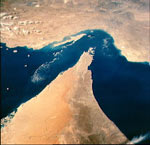 Reuters: An oil tanker owned and operated by Japan’s Mitsui O.S.K. Lines Ltd was damaged near the Strait of Hormuz on Wednesday.
Reuters: An oil tanker owned and operated by Japan’s Mitsui O.S.K. Lines Ltd was damaged near the Strait of Hormuz on Wednesday.
 July 28 (Reuters) – An oil tanker owned and operated by Japan’s Mitsui O.S.K. Lines Ltd was damaged near the Strait of Hormuz on Wednesday.
July 28 (Reuters) – An oil tanker owned and operated by Japan’s Mitsui O.S.K. Lines Ltd was damaged near the Strait of Hormuz on Wednesday.
The company said the damage came from an explosion, which injured one crew member, but the Omani coastguard said there was no evidence of an attack and that the damage came from a “tremor”. Iran reported an earthquake.
The ship, the “M. STAR”, was loaded with 270,204 tonnes of crude oil when the incident occurred in waters off Oman, Mitsui O.S.K. said.
It said the ship had been bound for Chiba port near Tokyo.
About 40 percent of the world’s traded oil leaves the Gulf region through the strategic narrows. Here are some facts about the Strait of Hormuz.
* WHERE IS THE STRAIT?
— A narrow bend of water separating Oman and Iran connects the biggest Gulf oil producers, such as Saudi Arabia, with the Gulf of Oman and the Arabian Sea.
— At its narrowest point, the strait is only 21 miles across.
— The strait consists of 2-mile (3-km) wide navigable channels for inbound and outbound shipping as well as a 2-mile-wide buffer zone.
* OIL SHIPMENTS:
— Oil movements through the strait account for roughly 40 percent of all seaborne oil traded in the world, according to the U.S. Energy Information Administration (EIA).
— The EIA estimates tankers carry between 16.5 and 17 million barrels of crude through the narrow channel daily.
— Ninety percent of oil exported from Middle East Gulf producers is carried through the strait.
— The bulk of the oil exported through the Strait of Hormuz travels to Asia, the United States and Western Europe. About three-quarters of Japan’s oil imports and about 50 percent of China’s pass through this strait.
— An additional 2 million barrels of oil products, including fuel oil, are exported through the passage daily, as well as liquefied natural gas (LNG).
— The world’s largest LNG exporter, Qatar, ships a total of 31 million tonnes annually through the strait to Asia and Europe.
— The EIA predicts oil exports passing through the strait will double to between 30 million and 34 million barrels per day by 2020.
— One of U.S. Central Command’s key missions in the Gulf is to ensure the free flow of oil and energy supplies.
— The U.S. Fifth Fleet patrols the Gulf from its base in Bahrain.
* TANKER WAR:
— Between 1984 and 1987, a “tanker war” took place between Iran and Iraq, where each country fired on the other’s oil tankers. Foreign-flagged vessels were caught in the crossfire.
— Shipping in the Gulf dropped by 25 percent because of the firing.
— Of the 239 tankers attacked, 55 were sunk or written off.
* STRATEGIC CORRIDOR:
— Merchant ships carrying grain, iron ore, sugar, perishables and containers full of finished goods also pass through the strategic sea corridor en route to Gulf countries and ports such as Dubai.
— Heavy armour and military supplies for the U.S. armed forces in Iraq and other Gulf countries pass through the channel aboard U.S. naval, U.S.-flagged and foreign-flagged ships.
Sources: International Energy Agency (IEA), U.S. Energy Information Administration (EIA), United Nations Conference on Trade and Development (UNCTAD), GlobalSecurity.org, U.S. Navy’s Military Sealift Command, Clarkson shipping consultancy, The Robert S. Strauss Center for International Security and Law.


